
views
X
Research source
Counting to 10 in Native Japanese (Wago) Style
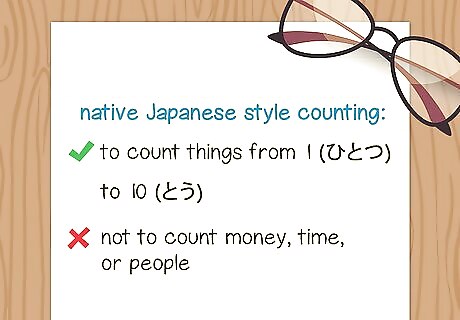
Learn when you can use the native Japanese style counting. Native Japanese counting tends to be simpler than the Sino-Japanese system and is only used to count things from 1 to 10. This set of numbers is also considered a universal counter. However, you can't use native Japanese to count money, time, or people. There are no counters in native Japanese style, which makes it simpler to use in daily life, for example, if you want to order 1 coffee or 3 pieces of sushi.

Start with the numbers from 1 to 5. Use flashcards or a similar method to learn the first 5 numbers in the native Japanese style counting. If you already know how to read hiragana, you can sound out the words. One (1) is ひとつ (hitotsu, pronounced "hee-toh-tsoo"). Two (2) is ふたつ (futatsu, pronounced "foo-tah-tsoo"). Three (3) is みっつ (mittsu, pronounced "mee-tsoo." Pause a beat between the two syllables). Four (4) is よっつ (yottsu, pronounced "yoh-tsoo"). Five (5) is いつつ (itsutsu, pronounced "ee-tsoo-tsoo"). There is no number for zero (0) in native Japanese style. For a zero, you would use the kanji character from the Sino-Japanese system.

Add the numbers 6 through 10. Once you've mastered the first 5 numbers, move on to the next 5 using the same practice methods you used for the first 5. Now you can count to 10 in the native Japanese, or Wago, style. Six (6) is むっつ (muttsu, pronounced "moo-tsoo"). Seven (7) is ななつ (nanatsu, pronounced "nah-nah-tsoo"). Eight (8) is やっつ (yattsu, pronounced "yah-tsoo"). Nine (9) is ここのつ (kokonotsu, pronounced "koh-koh-noh-tsoo"). Ten (10) is とう (tou, pronounced toh). You might have noticed that except for 10, all of these numbers end in "tsu" (つ). When you're reading kanji, you can tell which number system is being used based on whether the number ends with this symbol.
Using the Sino-Japanese System
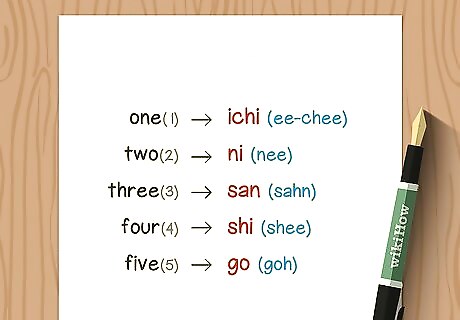
Memorize the symbols and words for the numbers from 1 to 5. The Sino-Japanese system uses kanji characters to represent each number. The pronunciations of these characters differ from the pronunciations of the native Japanese characters. Use flashcards or a similar system to memorize these characters and their pronunciations. One (1) is 一 (ichi, pronounced "ee-chee"). Two (2) is 二 (ni, pronounced "nee"). Three (3) is 三 (san, pronounced "sahn"). Four (4) is 四 (shi, pronounced "shee"). Because this word sounds like the Japanese word for death, the alternate pronunciation yon is also used – especially when talking about people. Five (5) is 五 (go, pronounced "goh").

Move on to the symbols and words for the numbers from 6 to 10. Once you've memorized the kanji characters and pronunciations of the numbers from 1 to 5, add the next 5. Practice until they come as smoothly as the first five. Then you are able to count to 10 using the Sino-Japanese system. Six (6) is 六 (roku, pronounced "loh-koo"). Seven (7) is 七 (shichi, pronounced "shee-chee"). Because this has the same shi sound as in the number four, the alternate pronunciation nana is common. Eight (8) is 八 (hachi, pronounced "hah-chee"). Nine (9) is 九 (kyuu, pronounced "kyoo"). Ten (10) is 十 (juu, pronounced "joo"). You can also use these kanji with the native Japanese system. Simply add the "tsu" (つ) symbol after the kanji character. For example, 1 would be 一つ. You would read it as hitotsu, not ichi.
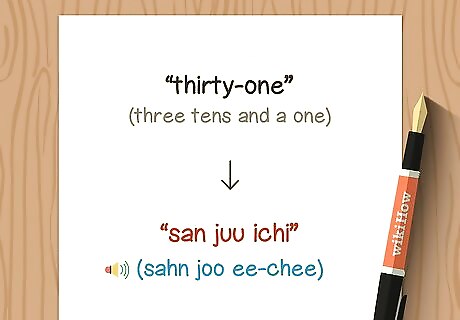
Combine symbols to create larger numbers. Once you know how to count to 10, creating larger numbers is a breeze. Unlike in English and other European languages, there are no new words to learn. If you break the number down into its parts and combine the symbols for each of those parts, you can count all the way to 99 with 10 characters. For example, 31 is 三十一: three tens and a one. You say it san juu ichi. 54 is 五十四: five tens and a four. You say it go juu shi.
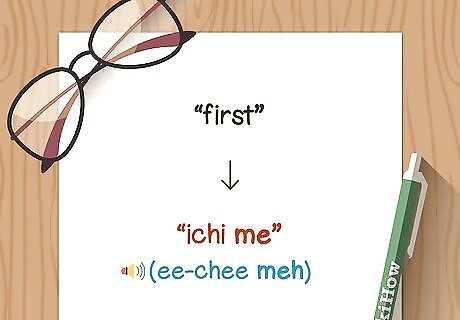
Add 目 (me, pronounced "meh") to use a number as an ordinal. If you want to refer to the "first" or "second" rather than the cardinal number, put a 目 after the number. Then read the number and the 目 together. For example, 一 目 means "first." You would read it ichi me (pronounced "ee-chee meh"). You do the same thing with larger numbers. For example, 三十一 目 means "thirty-first." However, in most cases you would be talking about the 31st something, such as the 31st time or someone's 31st birthday. To say that, you would need an additional character, known as a counter, that is appropriate for that thing.
Learning Basic Counters
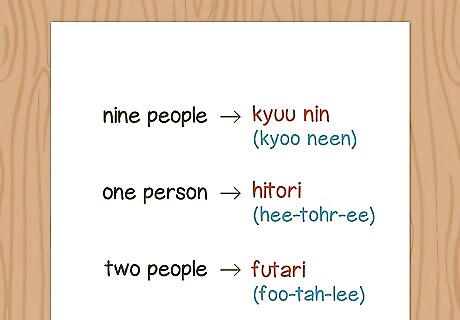
Count people with the 人 (nin, pronounced "neen") counter only. While many counter words can apply for broad categories of things, none of them can be applied to people. If you're counting people, you always add 人 after the number. For example, 九 人 (kyuu nin, pronounced "kyoo neen") means "nine people." The first 2 counters are irregular. If you're referring to one person, 一 人, you say hitori (pronounced "hee-tohr-ee"). If you're referring to two people, 二 人, you say futari (pronounced "foo-tah-lee"). For all others, simply add nin to the word for the number. Drawings coupled with Romanji can make numbers stick. "As a visual learner, I loved that this showed the numbers in hiragana with Romanized spellings. Matching the symbols to memorable drawings really helped the pronunciations click. Now I can finally distinguish similar-sounding numbers like nana and hachi!" - Sam L. Memorizing is within reach. "Despite struggling to memorize the numbers, this guide’s simple tricks allowed me to learn them just in time for an exam. Getting good marks showed me these techniques work, and now I’ll actually remember the numbers long-term. Scored well, thanks to clear memorization tips." - Lily W. You got this. "I learned Japanese years ago but forgot specifics like number order. Reviewing the pronunciations and symbols with these steps brought back lost knowledge, allowing me to dust off old skills. Now I can relearn with confidence!" - John S. Learning Japanese can improve your Karate skills. "Starting karate drills counted in Japanese, I wanted to ensure I knew the numbers. This taught me the difference between cardinal and ordinal forms, essential for following reps. Now I can participate smoothly thanks to this cultural insight." - Paul S. This guide can help build past the basics. "Initially seeking the basics from 1-10, I discovered helpful counters for objects versus people. This introduced key building blocks for continuing study. Now I grasp central counting conventions beyond my original goal." - Edith R. We want to hear from you! Advice from our readers makes our articles better. If you have a story you’d like to share, tell us here.
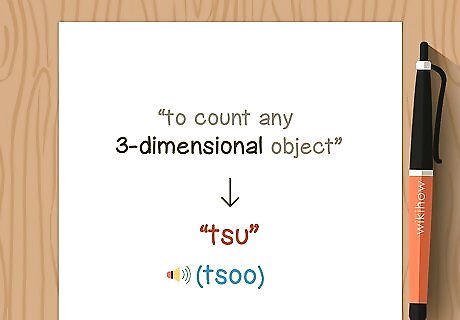
Use the つ (tsu, pronounced "tsoo") counter for any 3-dimensional object. While Japanese has hundreds of very specific counters, this one can be used to count virtually any object that exists. It works not only for solid 3-dimensional objects but also for things with no definite shape, such as shadows or sound waves. For numbers 1 through 10, つ is used with the native Japanese system, not the Sino-Japanese system. While this counter applies to any 3-dimensional object, it can also be used for abstract things, such as thoughts, opinions, ideas, or reasons. Use the tsu counter when you're placing an order for something – anything from a cup of coffee to pieces of sushi or concert tickets.

Try the 個 (ko, pronounced "koh") counter to count things with a clear boundary. The ko counter is almost as useful as the tsu counter and there is a lot of overlap between the two. However, ko has some limitations that tsu does not. For example, you can use ko to talk about the difference in ages between to people, but not about how old a single person is. Generally speaking, if you use either ko or tsu as a counter, your meaning will be understood.
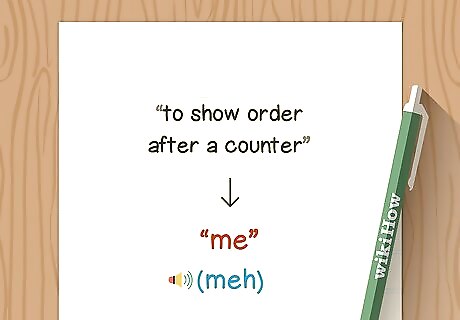
Add 目 (me, pronounced "meh") after a counter to show order. When using just a number and a counter, you express a number of the thing being counted. However, if you add 目 after the counter, it indicates the order in which that thing is placed (rather than the number). For example, 一回 means "one time." However, if you add 目 to it you get 一回目, which means "the first time." Similarly, 四人 means "four people." Add the 目 and it becomes 四人目, "the fourth person."

















Comments
0 comment